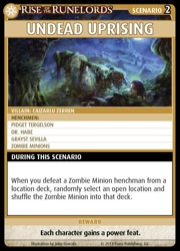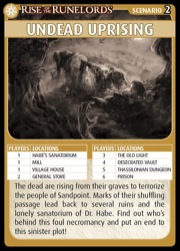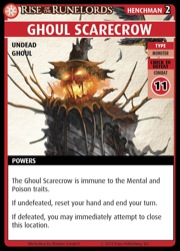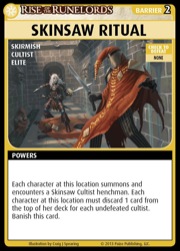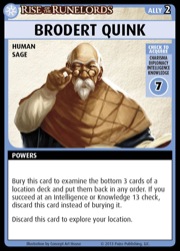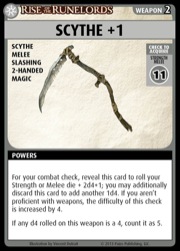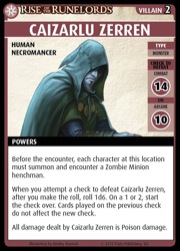With the release of The Skinsaw Murders fast approaching, Paizo has once again let me peel back the curtain a little to show off the new Adventure Deck. Since last time, we all have a great deal more experience with the game, and some of you have even started to speculate on what you might see in the second Adventure.
Those of you familiar with the Rise of the Runelords Adventure Path—or who've pored over the box for The Skinsaw Murders—know that there's going to be some creepy undead action ahead, perfect for an October release. Keeping with that theme, we'll jump right in with a little Undead Uprising. During this scenario, the restless dead keep rising all around Sandpoint until the adventurers manage to defeat a most unfriendly chap that we'll meet in a moment.
Our goal here is to create an ever-rising wave of undead all around town, combined with a sense of urgency without overwhelming the party. Adding henchmen to locations helps keep the undead presence high while making it more likely that the adventurers will close the locations before time runs out.
While the adventurers are probably in good shape to deal with a simple farmer or shopkeeper risen as a zombie, there are more menacing threats lurking in the dark places of Sandpoint, including these vile fellows:
Hiding ghouls inside the numerous scarecrows that dot the farms and fields outside of Sandpoint? Genius! Experienced Pathfinder players already know what a tremendous pain ghouls can be, and we think we've lived up to that promise here. In addition to the typical undead immunity to mental and poison effects, losing a fight with a ghoul scarecrow doesn't just hurt you; it also leaves you paralyzed for a short time. In PACG terms, in addition to taking damage from the Ghoul, you'll lose the ability to explore any further that turn.
What might be causing these undead uprisings, anyway? By the end of The Skinsaw Murders, you'll no doubt figure that out, but along the way, you might run into a particularly gruesome example of evil afoot, a Skinsaw Ritual.
During these macabre events, several cultists attempt to carve and mutilate the heroes as part of a grisly offering that hurts everyone present, including the cultists. If you've encountered cultists before, you already know how they advance the villain's plot—unless you can stop them.
Not all the news is bad, of course. Now that the adventurers have proved themselves heroes, the people of Sandpoint lend a hand, as best they can. For example, the noted sage Brodert Quink can be very useful, especially if called upon at just the right time.
Some characters will be able to call upon Brodert's sagacity more than once, but any of the adventurers can put the sage to good use. Changing the order of cards in a location deck is a very powerful ability, and Brodert can give you a peek at part of location deck that's otherwise very hard to see.
With the help of the estimable sage, you might find one of the new items, spells, blessings, armor, allies, or weapons added for the adventure. One especially thematic example is the Scythe +1:
In trained hands, this weapon can make quick work of any Ghosts or Spectres that might have plagued you in Burnt Offerings. As a "high crit" weapon, the scythe can land some devastating blows, adding as much as 16 to a combat check!
Speaking of devastating, let's take a peek at the troublemaker behind the uprising, and see what new tricks our villains have learned. Unsurprisingly, there's a necromancer behind it all (at least for now), and Caizarlu Zerren doesn't disappoint.
In addition to being constantly surrounded by a cadre of mindless undead, Zerren has picked up one of the favored tricks of the heroes: a mirror image effect! To top it off, the foul necromancer deals poison damage, neatly bypassing many forms of protection. All in all, we're hoping that Caizarlu is someone that you'll love to hate, and he's just the first of many. You'll also encounter ghosts, ghouls, ghasts, haunts, strange abominations, and more ghouls (more ghouls!) as you unravel the riddle of The Skinsaw Murders.
Thanks for playing!
Chad Brown
Pathfinder Adventure Card Game Developer

